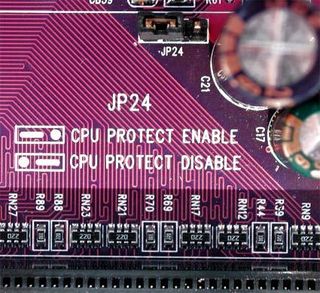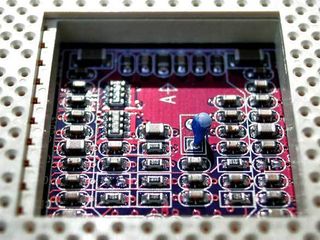A New Kind Of Fast: AMD Athlon XP 2200+
Now Required: Protection Against Thermal Death

On the Soltek board, thermal protection is activated via jumper.

Outdated: temperature monitoring underneath the CPU, using a thermistor.
About nine months ago, THG came out with the article Hot Spot: How Modern Processors Cope With Heat Emergencies , which caused quite an uproar in the industry and gave rise to considerable discussion. Accompanying this test was our first downloadable video , which shows the dramatic behavior of an AMD Athlon with the Palomino core (equipped with a thermal diode) when the CPU cooler fails while a system is running.
The alarm bells went off at AMD, and there were frequent meetings between the THG crew and the technical team at AMD and Siemens. A few weeks later, at a meeting with a small number of select attendees, AMD presented a circuit logic, which immediately turns off the power supply when the die temperature overheats to about 85 degrees Celsius. To guarantee failsafe protection, the CPU temperature is monitored frequently, in very short time increments, by the thermal diode. This ensures that the power is switched off in a timely manner. Since a few months ago, AMD has been distributing a new "Thermal Guide" to motherboard manufacturers in order to guarantee thermal protection for all new boards.

Thermal protection with the latest Asus KT333 board.

Thermal protection from Soltek with its new board based on the VIA KT333-chipset.
Stay on the Cutting Edge
Join the experts who read Tom's Hardware for the inside track on enthusiast PC tech news — and have for over 25 years. We'll send breaking news and in-depth reviews of CPUs, GPUs, AI, maker hardware and more straight to your inbox.
Current page: Now Required: Protection Against Thermal Death
Prev Page Chasing The P4: Athlon Core With A New Design, Continued Next Page Now Required: Protection Against Thermal Death, ContinuedMost Popular

